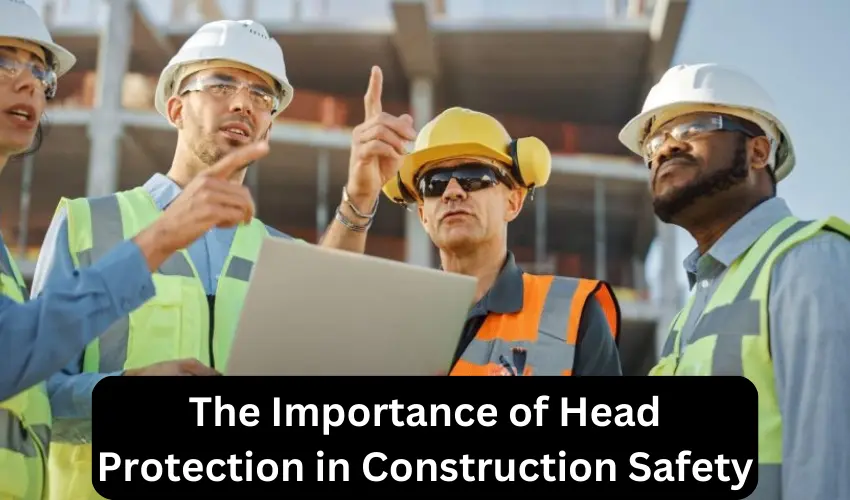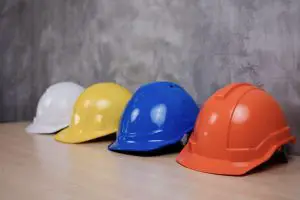Protecting employees/workers from experiencing head injuries is a central component of workplace health and safety. This is especially true in the construction industry where head injuries can quickly become life-threatening due to the nature of the job. We outline the importance of head protection in construction.

The Crucial Role of Head Protection in Construction Safety:
1. Guarding Against Falling Objects:
- Hard Hats as the First Line of Defense:
- Hard hats act as a crucial shield against falling objects, a prevalent hazard on construction sites.
- Impact Resistance:
- Modern hard hats are designed with impact-resistant materials to absorb and distribute force, reducing the risk of head injuries.
2. Protection from Overhead Hazards:
- Safeguarding Against Overhead Debris:
- Construction activities often involve overhead work, making head protection vital in shielding against debris and materials that may fall from elevated areas.
- Preventing Traumatic Injuries:
- Hard hats play a pivotal role in preventing traumatic injuries that can result from overhead impacts.
3. Mitigating Electrical Risks:
- Electrical Insulation:
- Hard hats with electrical insulation properties protect workers from electrical shocks on sites with live wires and electrical equipment.
- Compliance with Safety Standards:
- Ensuring that hard hats meet relevant safety standards is crucial for effective protection against electrical hazards.
Also Read: What to Look for When Choosing an Electrical Hard Hat
4. Enhancing Visibility and Communication:
- Integration of Communication Devices:
- Some modern head protection equipment allows for the integration of communication devices, enhancing coordination and safety on construction sites.
- High-Visibility Options:
- High-visibility hard hats contribute to better visibility, reducing the likelihood of accidents, especially in areas with heavy equipment and machinery.
5. Weather and Environmental Protection:
- Shielding Against the Elements:
- Head protection extends beyond impact resistance to shield workers from weather elements such as rain, sun, and falling snow.
- Promoting Comfort:
- Comfortable and well-ventilated hard hats encourage consistent use, promoting overall worker well-being.
6. Preventing Head Injuries from Collisions:
- Collision Protection:
- Hard hats provide essential protection in scenarios where workers may inadvertently collide with structures, equipment, or each other.
- Reducing Severity of Injuries:
- While not a substitute for proper safety practices, hard hats significantly reduce the severity of head injuries in case of collisions.
7. Cultivating a Safety Culture:
- Symbol of Commitment to Safety:
- The consistent use of head protection fosters a safety culture on construction sites, emphasizing the importance of risk mitigation.
- Setting a Standard:
- Implementing and enforcing head protection measures sets a standard for safety, encouraging workers to prioritize their well-being.
OSHA Requirements
If worn properly and consistently, hard hats will protect your head from trauma. It is OSHA Standard 1926.100(a), which states that individuals working in industries wherein there is the potential of danger from head injuries due to falling or flying objects, impact, burns, or electrical shock, must be protected using protective helmets.
For this rule to be effective, protective helmets and hard hats need to absorb shock, resist penetration, and be water- and fire-resistant. They must also contain easily understandable instructions that explain how to properly adjust the device and replace the headband within the hard hat.
In industries that may not have an OSHA requirement for head protection, companies may enforce 100% protective headwear use. However, the usage of hard hats or head protection should never be a substitute for engineering controls and proper safety practices.
When do I Require Head Protection?
Job site hazards that require the use of head protection include:
- Burns or electrical shock from exposed electrical conductors
- Low overhead or with fixed objects like beams, pallet racks, piping, and heavy equipment
- Confined spaces where workers could bump their heads
- Flying, falling, or moving objects
Additionally, head protection should be worn while working below fellow employees who are utilizing materials and/or tools that could fall. While OSHA rules indicate that protective headgear needs to be worn when falling objects or hazards are present, this isn’t the only time they are required on a job site.
What Hazards Should Workers Be Aware of?
Workers should be aware of potential hazards that can injure their heads, such as:
- Flying particles or parts from a conveyor, grinder, or material being cut
- Falling items like tools, packages, boxes, parts, and other stored or racked pieces
- Moving pieces, objects, or parts handled from overhead lifting equipment
- Racks, shelves, pipes, or other structures they walk under
- Wires, energized parts, or electrical lines
Workers should make sure their hard hat fits properly. If it is too small or too large, it will not provide proper protection–even if all the requirements are met. Head protection must be worn properly to be completely effective. Helmets shouldn’t slip, fall off, irritate the skin, or bind. Some hard hats were created to fit one size and others are adjustable. Find one that best fits you.
Workers should always follow the manufacturer’s instructions to ensure the protective equipment is properly fitting.
Since protective headgear is designed to keep space between the worker’s head and the shell of the hard hat, avoid adding any liners or accessories that aren’t compatible with the helmet or aren’t manufacturer-approved. OSHA states that employers may permit liners only if they are designed specifically to be compatible with the hard hat. Baseball hats should never be worn underneath a hard hat.
Not All Hard Hats Are the Same

OSHA requires that all hard hats meet special requirements. They need to abide by the ANSI Z89.1 standard and be marked with the approval symbol. A Type 1 hard hat will protect both the top and side of the head from impacts.
The maximum amount of voltage that hard hats protect the wearer from will depend on several factors like the equipment, care taken in maintenance, electrical circuits, and weather conditions. Workers should not wear aluminum hard hats in areas where they may contact energized circuits.
The three classes of hard hats that protect against electrical elements are:
- General or Class G hard hats provide some protection against electrical hazards
- Electrical or Class E hard hats provide significant protection from electrical hazards
- Conductive or Class C hard hats do not protect from electrical hazards
Steps Workers Should Take to Maintain Their Head Protection
Always inspect your hard hat before wearing it. This includes all accessories and components. Look for any indication of damage like cracks, dents, holes from penetration, or damage from wear, impact, or rough treatment. These will reduce the amount of protection provided by the hard hat.
If the hat has been extensively worn, is defective, or is damaged, it shouldn’t be used. Any hard hat that has experienced a blow could have a reduced ability to protect. It should be replaced as well.
If you notice during your inspection that the helmet has lost its glossy finish, has a chalky appearance, or the shell is flaking, this may indicate damage from UV radiation. This will cause the helmet to lose its effectiveness.
Hard hats shouldn’t be stored on the rear window shelf of vehicles. Extreme heat and sun can cause it to degrade. Furthermore, it can quickly become a flying hazard while driving if you need to suddenly hit the brakes.
Hard hats should not be thrown, used for support, or intentionally dropped. This will affect the safety of the device. Additionally, they shouldn’t be modified or altered in any way unless the modification is approved by the manufacturer.
Important tips:
- Replace your head protection if it has experienced an impact, even if it isn’t noticeably damaged.
- Hard hats should be replaced if damage begins to show.
- Accessories that compromise the hard hat’s safety should not be used.
- Ensure that your head protection fits your head properly. If the fit isn’t right, you will not be fully protected.
- Workers should receive training to recognize hazards that need head protection. They should be aware of how to wear and maintain the hard hat. Also, they should know when to replace it.
- Workers need to wear the appropriate protection if they will be exposed to electricity.
- Hard hats need to be marked with ANSI Z89.1.
- Always be aware of hazards your head may A hard hat can only protect you from so much.
Conclusion
Head protection is necessary to protect you from experiencing severe physical damage. Brain injuries are no joke and can cost you your life. Always keep safety at the forefront and be careful to maintain your head protection. That way, it will always keep you safe.
Related Resources:
- The Advantages of Vented Hard Hats for Hot and Humid Work Environments
- Top 5 Full Brim Hard Hats for Construction and Landscaping
- Industrial Safety Helmet vs Hard Hat: What Are the Differences?
- 6 Tips for Choosing the Right Construction Outfit & Work Clothes
